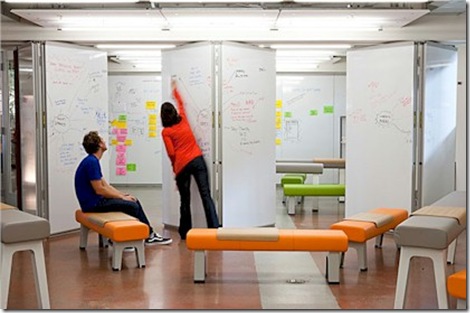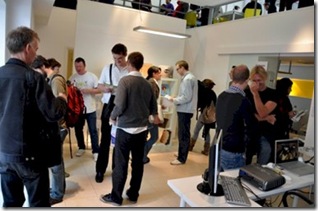
Management By Walking Around’ (MBWO) has been meandering through the corridors of management gurudom for at least as long as I have been in the business these past two decades. Supposedly, it was first introduced by HP founders Dave Packard and Bill Hewlett and later popularised by management guru Tom Peters. The notion was that a manager who did not sit in his corner office, but instead came out and mingled with his team got two benefits. First, the staff would be inspired by a more regular, more direct relationship with their leader. Second, the manager would have a more direct, more spontaneous, more immediate understanding of the business and its issues.
In the world of Dynamic Work, the imperative to get out of the expensive, space-inefficient dedicated office is even more acute. But the prescribed alternative…’walking around’…might not be the best approach. Perhaps in an environment with hustle and bustle and toing and froing, the manager could slip stream right into the eddies of activity. But modern knowledge work is a bit more sedentary grounded around the central tool of the PC. The PC anchors the knowledge worker who then pivots to phone, to other tasks and to chatting with colleagues.
When I run Business Value Productivity Services workshops with companies, the spontaneous and serendipitous interaction between team members is often raised as an extremely critical ‘shadow’ business process. In the open plan environments that predominate in many UK companies, the low partition desk units facilitate this casual interchange and collaboration. To take this principle of MBWO into the modern office, however, I propose that one changes from ‘Management By Walking Around’ (MBWO) to ‘Management By Sitting Around’ (MBSA).
Managers can take their PC work (emails, spreadsheets, documents, online resources) anywhere (save a few exceptions for some confidential stuff). And that includes smack down in the middle of their team. I practiced this approach as a senior manager at Microsoft and the dividends were massive.
- More Relaxed Sharing – By my mere proximity and involvement in trivial banter, the staff felt more comfortable in raising small issues on the fly. For many issues, they would otherwise not have wanted to make a ‘big deal’ out of by getting up, coming over to an office and making a pronounced interruption. But often, these small issues served as considerable obstacles to them moving forward. The one minute, quick, casual answer from me saved them many minutes of wrestling with it for no purpose. Also, keeping close to these ‘small’ issues gave me a much better sense of the bigger issues in the team as I had many more data points of real instances of things that were actually impeding progress.
- Passive Mentoring – My location allowed for a degree of casual and indirect mentoring. Many team members sat in ear shot. They could hear me on routine phone calls which allowed them to see how I dealt with and articulated a range of subjects. They could overhear the answers I gave to the people who shouted out their quick questions (it was not unusual after I responded to a team member’s question for someone to shout out, ‘what was that you said?…I’m having the same problem…’).
- More Natural – I have seen some of the more ‘pointy-hair’ breed of managers try MBWO (see Dilbert above), and often it is awkward, contrived and sometimes downright creepy. These managers have read their guru articles, but just aren’t sure what to do next once they start their pathetic peripatetics. The ‘Sitting Around’ approach is much more natural. If push comes to shove, the manager just goes ahead and does what they would have done at their desk.




